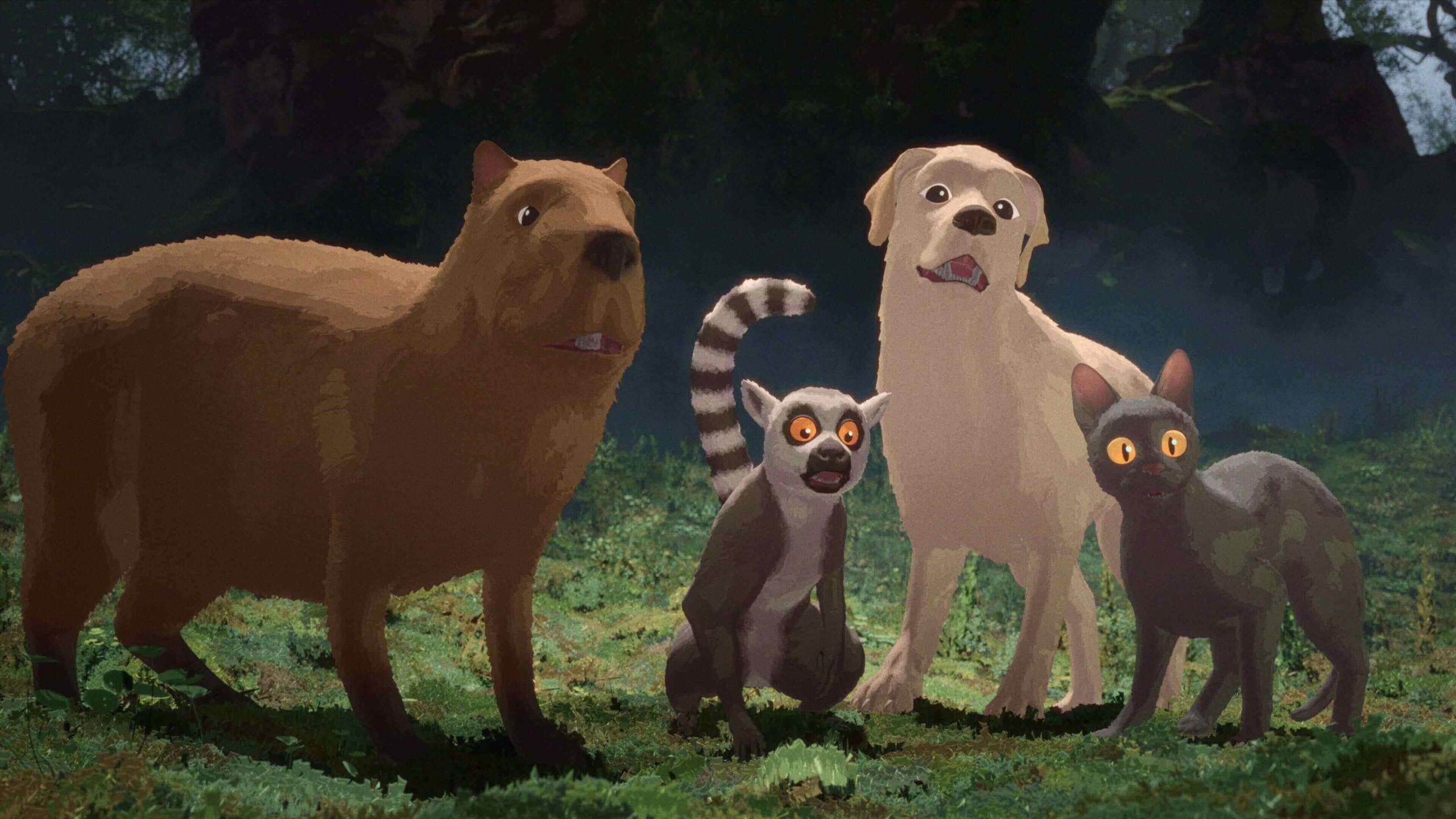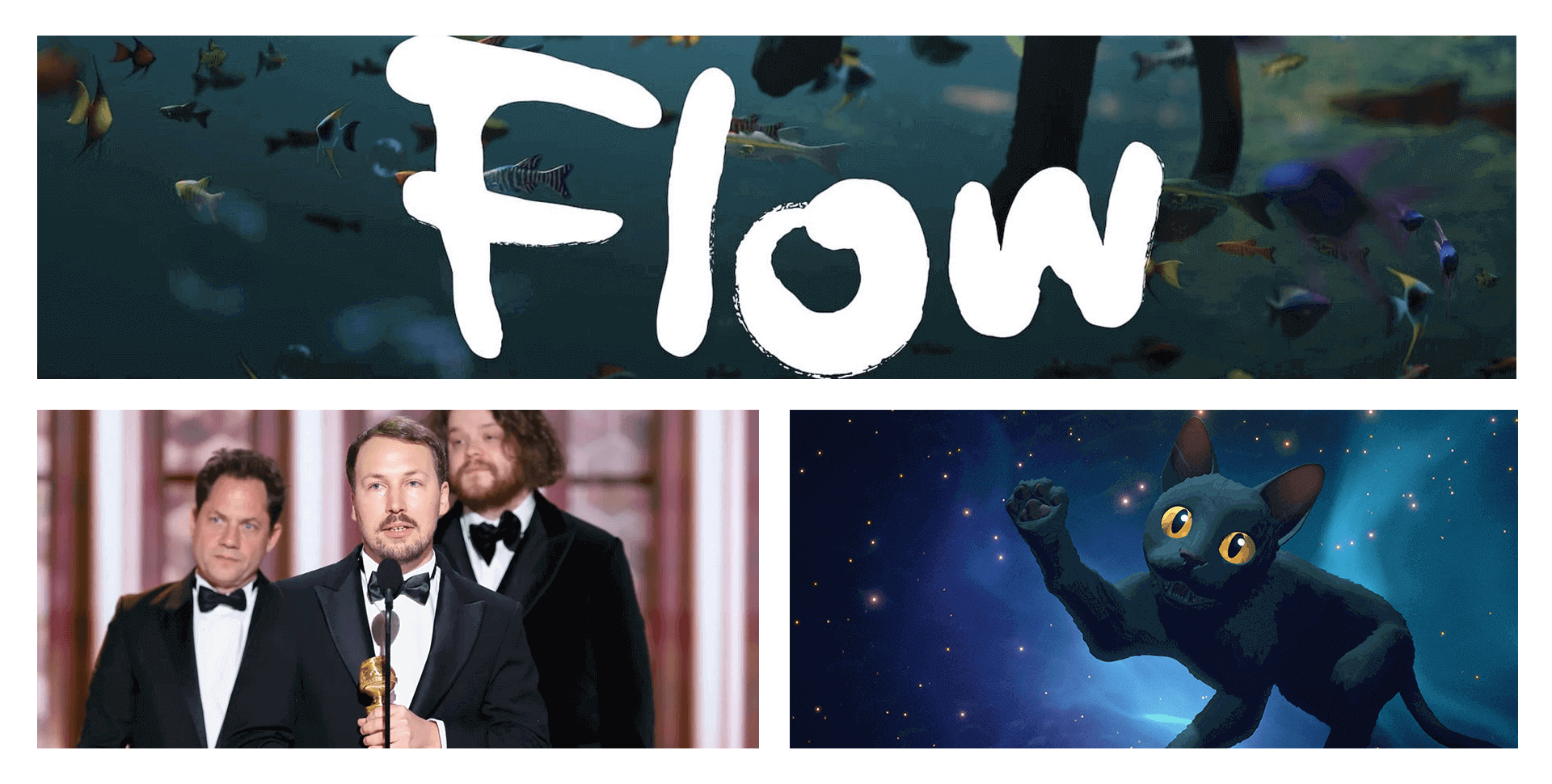Picking up the Golden Globe for Best Animated Feature, Flow emerged as one of 2024’s freshest animated movies with its moving tale of a cat surviving a catastrophic flood. In this interview, co-writer/director and co-composer Gints Zilbalodis explains why he chose to have his animal characters not talk like humans, why he animated the film on free software like Blender, and much more.
Listen here. The following transcript has been edited and condensed for clarity:
Hello, I'm Shaurya Thapa of Borrowing Tape, and today I'm joined with Gints Zilbalodis, who is the director, writer, producer, and even co-composer of the 2024 Latvian animated film Flow. Now, Gins, first of all, congratulations for Flow, for making it to the Golden Globes nominations and the Academy shortlist.
Thank you. Thanks.
I personally caught it at the BFI London Film Festival this year in IMAX, and it was quite an experience for me.
That was really cool. I wish I could have seen it. I was at London, but I couldn't go to that screen.
So Gints, Flow is a tale of survival as a cat and a few other animals escape a flood in this makeshift boat. It's almost like Noah's Ark, minus the humans; where did you get the inspiration for a story like this?
Well, this story started when I was in high school. I had a cat, and I made a short film inspired by this cat. The premise was about a cat overcoming its fears of water. And that was basically it. Then many years later, after making a few more shorts and my first feature film, Away, I had an opportunity to work with a team with a proper budget. And I thought I should tell a story about the character who has to learn how to collaborate, how to work together, and I thought the cat would be a great protagonist for such a story. So I revisited the premise of one of my earlier shorts and added a bunch of more characters, including a dog which is inspired by dogs I've had and, this time, really focusing more on the cat's fear of other animals. The water is still there, but the story is really about the relationships of these characters.
Talking about the other characters in your film. Based on the opinions of many who enjoyed Flow, like I was reading a lot of Letterboxed reviews as well on Flow, and while everyone loves the cat, everyone loves the dog, there's a particular fascination towards the capybara. A lot of people love the capybara, me myself included, because no matter how stressed out the other animals felt, the capybara was chill, he was calm, he was zen. So again, you tell me a little more about the capybara character; what's your perspective on it?
Yeah, it's kind of an aspirational figure, I think, especially now, in times where it's very stressful and anxious; I think people wish to be more like the capybara, to be able to relax like that. We have four other characters, the cat, the dog, the lemur, the secretary bird, and all of them change and learn something and go on their own character arcs. The capybara is the only one that doesn't change. It's like a mentor figure to everyone, teaching them how to just relax and trust each other. But the capybara also tends to always try to diffuse the situation and make everyone be friendly and invite everyone on the boat. And it wants to do good things, but sometimes, this creates more conflict in indirect ways. But yeah, I think real capybaras seem to be like that; they seem to get along with all kinds of animals. These animals, we started from what we think of them, their personality is like the cat, grumpy and independent, and the dog is friendly, and the capybara is relaxed. And so that's how we start them. Gradually, we try to challenge them and have them change and act in some contradictory ways.
But what makes Flow all the more realistic is that the animals are not talking like humans. It's largely a silent film. So, was it always your plan to make the animals not talk or behave how they would in the real world?
Yeah, that was always the plan. And that's how we always pitched it. And all the films I've done so far are without dialogue. So it wasn't really a decision for me. It's something that I'm more used to, actually. And we've seen these talking animal films. And I think that's been done so many times. I think having them not talk gives us a kind of fresh perspective. And I think it makes the story more engaging and emotional, seeing real animals go through this, instead of some animal who basically behaves human. I think that the stakes wouldn't be as big, and the world would seem smaller that way.
And yeah, I think these animals are so interesting and have meaning; they have like deep meaning, and they are also so funny that we don't need to change them that much to make them interesting. And yeah, not having dialogue also allows me to use the other tools of cinema. I can push them a lot further, the music and the sound and the camera and editing.
Then, the story becomes universal. We don't need to translate it, and everyone can understand it. For that reason, I never considered actually putting humans in the story. I wanted to give the idea that humans have been here, but yeah, we don't see them. Because if there would be humans, they would need to speak. So that would break the whole concept.

What were some of the animated or non-animated films that inspired Flow, either in terms of story or visuals? What were some of your inspirations?
I think I'm more inspired by live-action filmmakers than animation filmmakers. Of course, I love Studio Ghibli and Miyazaki, but I think in terms of this, like the camera, it's more like Alfonso Cuaron['s] approach with the long takes, and also like the handheld movement, but also like having multiple stories happening at the same time within the frame. You, as an audience, can look around within the frame, and see something in the foreground, but there's also something in the background, and have like wide angle lenses that allows that. Yeah, it's a different sensibility. So I wanted to have that feeling that there's a real person holding the camera and having these human imperfections, which I think make it more immersive and grounded.
Talking about immersive — so, what made you and your team animate this movie largely on the software Blender, like the 3D feel that we get from yourself — why did it choose that instead of, let's say, something more traditional like hand-drawn 2D animation or even Pixar-style CGI visuals. What was the rationale behind going Blender?
Well, yeah, Blender is a free open-source tool, which means that everyone, any kid, can pick it up and make their own films, which I think is very cool that also feature films shown in cinemas, can use the same tools. And it's a tool that's just as good as any other paid tools. And there isn't one style for this software. You can do a film like Flow, but you can do something more realistic. It's just a creative decision that we made to make the film look like this. But yeah, we needed to do it in 3D, like using CGI, because you can't draw a film like this. The type of camera movement and that kind of immersive feeling. I think this is the only technique we could use. And yeah, I don't even draw storyboards. I create the scenes, the animatic in 3D, kind of just discovering it. And I can have this virtual set and explore it with the virtual camera. And it's almost like location scouting and a live-action film where I don't know exactly what I will end up with. I know some filmmakers can imagine everything perfectly in their heads and then describe it and build it. But I need to go through that process of discovery and trying out different things. And it's very intuitive. I think more intuitive and spontaneous than most animated films. I wanted to avoid that rigid approach where we're just following the rules and following the set path. I wanted it to feel very organic that we don't know what's going to happen and to create these human imperfections that way.
Your first feature film, an animation, was Away in 2019. So from 2019 to now, what exactly, like from Away to Flow, what exactly has changed for you as a filmmaker?
It was a big change now working with the team, which I hadn't done. And we established our studio in Latvia since then, where we made Flow. And so I've learned so much as well from working with all these different people. The plan is for me to delegate a little bit more with each of the films. So I know some filmmakers make a small indie success, and then they go on to make something huge. And I think maybe there's a chance of losing your voice this way and being too overwhelmed by working in such a different way. So I'm trying to do it gradually, where I wasn't doing everything like I did with Away, but I was still very involved in Flow, doing all kinds of stuff. But with the next film, I want to do a little bit less because now I've found the team, and I think I can trust them. And also, I learned how to articulate my thoughts better. But it's still like a learning process. I never think I will feel like I know everything, like with each project, I'm trying to challenge myself and doing something I've never done. So the next film will be something very different that I haven't tried before.
All right. My last question for you, Gints, is, compared to all the animals in Flow, the cat, the dog, the limo, the capybara, and the birds, what animal would you relate to the most? What animal do you feel like? Okay, that's me if I was surviving a flood with a couple of other animals.
Well, quite by design, I think I relate to the cat, which is like, it's a personal story to me about learning to collaborate, and the cat has to do the same in the film. But yeah, there are aspects of me in all of these characters. And yeah, so I wish I could be the capybara, but I think I'm more of the cat.
Watch Flow
